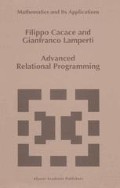Abstract
The aim of this chapter is to give an overview of the recent evolution in database technology from the conceptual and practical perspective of the data modelling and data manipulation facilities provided by novel database systems.
Access this chapter
Tax calculation will be finalised at checkout
Purchases are for personal use only
Preview
Unable to display preview. Download preview PDF.
Note
Observe that, in contrast with this interpretation, time is continuous in nature, that is isomorphic to real numbers, while discrete time is isomorphic to natural numbers, or a subset of natural numbers. However, both continuous and discrete interpretations assume that time is linearly ordered. Discrete interpretation of time is motivated by its simplicity and ease of implementation.
By contrast, as we shall see, the data model of Algres allows relations to be logically linked together by means of a special conceptual construct called link.
The whole set of dependents of a supervisor X includes the direct dependents of X, as well as all of the employees who are recursively dependent of the direct dependents of X.
The reader should not be confused by the use of the same variable names X and Y in the specification of rule constraintViolation and the relevant query. In the former, X and Y denote respectively the name and the age of the manager violating the constraint, while in the latter these variables are used to represent the name of the specific violated constraint and the list (that is the collection) of the variables participating in the incorrectness.
The transformation is based on the logical equivalence A ∧ (B ∨ C) = (A ∧ B) ∨ (A ∧ C). The latter is a disjunctive normal form as it consists of a disjunction of conjunctions. In contrast, a conjunctive normal form consists of a conjunction of disjunctions, such as (A ∨ B) ∧ (C ∨ D).
In object-oriented programming languages such as C++, objects of a given class are not automatically maintained in any container, so that set-oriented operations applied to the whole set of similar objects cannot be performed.
For practical reasons, in several object-oriented database systems, the set C1, C2, …, Cn of superclasses of a class C is actually an ordered set (a list).
Considering for example an attribute friend: Person, the restriction (or refinemant) of the domain of friend is a subclass of Person (e.g. Student).
It is also possible to use views to have as unit of authorization a subset of the tuples of a relation.
Besides objects, authorization hierarchies may also be defined for subjects and authorization types.
Recall that an exception is an error condition occurring in the execution of the operation.
The term triggered may be confusing as it might erroneously give the impression that the triggering of a rule means the execution of the action part of the rule. Triggering a rule means simply that, due to the occurrence of a relevant event, the condition part of the rule is evaluated and possibly (but of course not necessarily) the action part executed.
Active rules can be used to monitor traditional static integrity constraints as well as dynamic and realtime constraints, that is constraints on sequences of database states occurring over time. For example, a static constraint may specify that the salary of an employee cannot exceed the salary of the relevant manager, while a dynamic constraint might assert that the salary of an employee cannot be decreased.
Author information
Authors and Affiliations
Rights and permissions
Copyright information
© 1996 Springer Science+Business Media Dordrecht
About this chapter
Cite this chapter
Cacace, F., Lamperti, G. (1996). Overview of Recent Evolution in Database Technology. In: Advanced Relational Programming. Mathematics and Its Applications, vol 371. Springer, Dordrecht. https://doi.org/10.1007/978-94-007-0858-7_2
Download citation
DOI: https://doi.org/10.1007/978-94-007-0858-7_2
Publisher Name: Springer, Dordrecht
Print ISBN: 978-94-010-3742-6
Online ISBN: 978-94-007-0858-7
eBook Packages: Springer Book Archive

